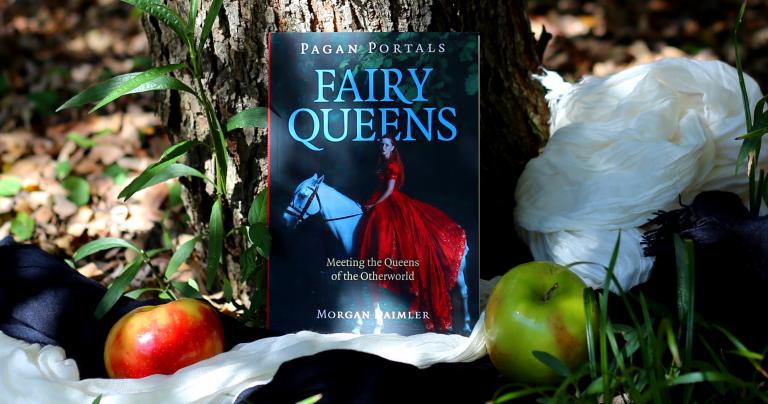What an amazing time to be a Pagan!
While we have a long way to go toward true religious equality, we can openly profess beliefs and practices that would have gotten us burned at the stake less than 300 years ago. Arcane books that were difficult to find and dangerous to own are delivered to our doorsteps in days. And the state of our art is constantly being advanced by practitioner-leaders who are doing things that previously were only whispered about in secret and then writing about them to provide guidance for those who come after them.
Some of our books and blogs are works of scholarship. Others – like mine – are guides to practice. Still others combine both scholarship and practice.
And that brings us to Fairy Queens: Meeting the Queens of the Otherworld by Morgan Daimler. This is a new offering from Moon Books “Pagan Portals” series of short, concise guides to topics of interest to Pagans. It’s a work of scholarship that covers the literary and folkloric material about the various Queens of Fairy. And as the subtitle promises, it’s a guide to meeting them and interacting with them.
I’m thrilled this book now exists.
People have seen fairies and dealt with them (sometimes skillfully – many times not) throughout recorded history, and likely long before. They told stories about their encounters, and the more memorable and useful stories were passed from generation to generation. Eventually some of them were written down.
The problem is that the writers usually had a different point of view from those who told the stories. Even those who attempted to faithfully record what they heard rarely believed they were anything more than stories told by uneducated and unsophisticated people. Or in the case of transcripts from the witch trials, people who had been deceived by the devil.
So when we read these books today – even though reading them is necessary and helpful – we’re rarely if ever getting a first-hand report from the people who actually encountered the Fair Folk.
If your interest in the Good People comes from ordinary curiosity, that may not make much difference. On the other hand, if you find a Goblin Market setting up shop across the street from you, you need guidance from people who’ve been there, done that, and lived to write about it.
Morgan Daimler has been there and done that, and has written several books on the Fair Folk. The most extensive of them is Fairies: A Guide to the Celtic Fair Folk (2017). It includes a chapter on “The Kings and Queens” but that chapter is mainly a listing of names with a paragraph or so of what’s known about them. It’s enough to help you recognize some of the royal persons in Fairy, but the focus of Fairies is much broader than its Queens.
Fairy Queens begins with this introduction:
The Fairy Queens are alluring and mysterious, sometimes easy to find yet often difficult to understand.
Fairy Queens consists of three main elements woven together into one book. One is a biography of six Queens, two from Scotland and four from Ireland. They are the Queen of Elfland (known only by her title), Nicnevin, Áine, Aoibheall, Cliodhna, and Una. The chapter on each Queen begins with what is known of her from folklore. For example, Áine is usually associated with the area around Lough Gur, while Aoibheall is the Fairy Queen of County Clare. Nicnevin is first mentioned (in writing, that is) in a 16th century poem by Alexander Montgomerie, then again by Sir Walter Scott in 1831.
The second element is a review of Fairy Queens from literature and pop culture. These Queens were not part of folklore, but some of them aren’t exactly new. They include Mab and Titania from Shakespeare, and Morgen la Fey from the Arthurian tradition. Some of them have been adapted by contemporary writers such as Jim Butcher. We can’t dismiss any of these Queens. As Daimler says:
For many people their introduction to the Queens doesn’t come through folklore or literature but through fiction in some form, and this must be respected and also understood in context.

The third element is a series of journeys to meet these Queens, as well as a guide to interacting with them safely. Understand that Fairy is not an egalitarian society and Queens are used to receiving respect and deference. At the same time, you are still a person with agency – you can say no. Just do it in as polite a manner as possible.
Daimler explains the difference between journeys and guided meditations much the same as I do. A guided meditation takes place entirely within your mind, so you can control it. A journey uses similar methods, but it takes you into a spiritual realm with other persons who have agency of their own. You can’t control them, and what happens there has consequences that can continue after you return to the ordinary world. Guided meditation is mostly safe. Journeying isn’t.
Each journey begins with this warning:
Listen to whatever your Guide tells you; promise nothing and give nothing that you are not truly willing to lose; never forget for a moment who it is you are dealing with.
As with all the Pagan Portals books, Fairy Queens is not intended to be an all-encompassing reference. It includes a bibliography of sources, primarily from folklore. Daimler encourages readers to dig deeper into the resources that exist, including seeking out storytellers in living cultures where fairies are still acknowledged. I agree with that recommendation.
But the true follow-on to Fairy Queens has yet to be written. It falls to the next practitioner-leader to undertake these journeys, form relationships with one or more of the Fairy Queens, fulfill the terms of their agreement, and then write about their experiences.
If that is you, this book is where you need to begin.
Fairy Queens: Meeting the Queens of the Otherworld
by Morgan Daimler
published by Moon Books, October 2019
104 pages
trade paperback: $10.95, e-book: $5.99
For those who care about such things, Moon Books sent me a review copy of Fairy Queens. However, I do not review books differently based on how I get them. Morgan Daimler is a friend and a colleague, but if I thought the book wasn’t worth your time and money I’d conveniently forget to review it (seriously – there’s another book by another author sitting on my desk right now and it’s not going to get a review). My only obligation in a review is to the reader. Fairy Queens isn’t for everyone, but if you have any interest in the Fair Folk and their Queens, I highly recommend it.

















